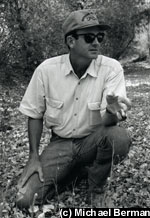Ask any rancher — these days, desperation is a lot more plentiful than grass on the western range. Beset by a lousy beef market and increasing costs, it is virtually impossible to make a cattle ranch pay.

Jim Winder in ranch dressing.
Jim Winder knows this very well. So this fourth-generation New Mexico rancher has branched out into bird-watching, building homes with low-impact materials like straw bales, and restoring wetlands. These pursuits pay. They pay so well that Winder’s operation is expanding while many ranchers are barely hanging on. He divides his 900 head of cattle between two ranches, and has capacity for 600 more on a third.
“We’re trying to use a small amount of real estate development” to float the ranching operations, explains the 38-year-old, who lives with his wife and two children on the family ranch near Hillsboro. “Then we strip out the development value [of the undeveloped land] and get it into conservation easement so development won’t be a pressure anymore.”
Winder, who once served as local chair of the Sierra Club, has always been conservation-minded. He has restored a riparian area on his ranch, and in 14 years of ranching, he has killed a total of just two coyotes. Lately, he’s became increasingly concerned about the growing development pressures on New Mexico’s open spaces.
A couple of years ago, the Lake Valley Ranch, which encompasses 52,000 acres just southwest of the Gila National Forest, was being eyed by real estate developers. “Around here, we’re not talking townhouses,” says Winder. “We’re talking mobile homes.” It was a beautiful piece of land. Two creeks, the Berrenda (meaning antelope) and Jaralosa (meaning seep willow), wound through its canyons, feeding a network of wetlands that hosts 150 species of birds. Winder bought the ranch, and with help from the Rocky Mountain Institute in Snowmass, Colo., and state and federal wildlife officials, developed a plan to limit development to 15 homesites hidden in the hills on a small portion of the land and keep the rest of it open for ranching and recreation by homeowners. Winder also built a guest house on the ranch that hosts visiting birders who come to watch critters like the yellow-billed cuckoos and bright-red vermilion flycatchers. Conservation-minded early retirees snapped up the15 parcels. “It’s good for the buyers, because they get to use the whole ranch,” says Winder. “It’s good for me, because I get to ranch.”
The cattle raised on the ranch are often marketed as “predator-friendly.” At Lake Valley Ranch, as on the family operation, Winder avoids predators rather than killing them. “We moved the cows around to make them less susceptible to coyotes, and kept out of known coyote areas during calving. We’re trying to bend to fit nature.” He’s reintroduced an endangered fish, the Rio Grande Chub, into Lake Valley’s creeks, and is working to restore the wetlands that had historically been drained for irrigation.
More recently, the Corona Ranch, 30,000 acres of rolling pinon juniper forest on a distant mesa in the Cougar Mountains between Albuquerque and Ruidoso, came up for sale. It was going to be turned into 500 homesites. Winder bought it, limited development to 24 one-acre building parcels, and thereby stabilized the whole operation financially.
“Most of what I do is almost the opposite of the philosophy of typical ranching,” he says. “It’s not what you take, it’s what you can leave. I don’t want to sound like some Zen contrarian; I’m not some brilliant guy. I just see there’s more out there than cows.”
He’s happy to be part of an emerging “middle-of-the-road, get-it-done, don’t-go-to-court” trend in the environmental movement. “When I was chair for the Southern New Mexico chapter of the Sierra Club, I honestly can’t tell you if I did any good for the environment the whole time I was there. I made a lot of phone calls; I wrote a lot of letters. Now we can go to Lake Valley and find some endangered fish and a lot of birds.
“We’re not hitting any great home runs. We’re just doing a lot of things that slowly add up.” And, he notes with real wonder in his voice, “You can get $100 a day from bird watchers.”


